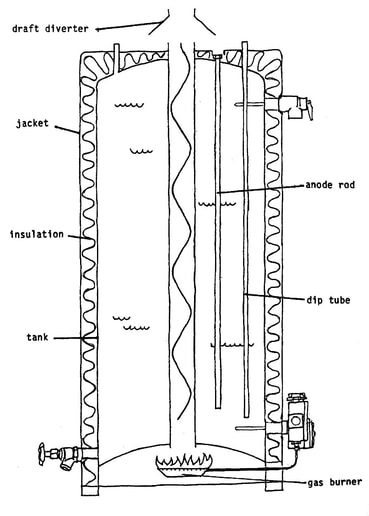 Let’s start with a little background. A dip tube is simply a pipe inside of a water heater tank, which delivers cold water from the connection on top down towards the bottom. Hot water floats on top of cold water; that’s called stratification. If a dip tube cracks or breaks off, cold water can mix with the hot, higher up in the tank, de-stratifying (mixing) the tank, so that you get a luke-warm shower, or worse! Keeping cold separated from hot is the dip tubes’ main function. It allows 70 to 75% of the water in the tank to be used as undiluted hot water. The reason most heaters have dip tubes instead of simply hooking up the cold inlet at the bottom is that it's safer (and easier to install). What makes it safer is that if the main water supply line breaks, a bottom connected tank could empty, making for a dangerous situation when the tank starts reheating. A properly working dip tube will leave the tank mostly full of water because there is a small hole drilled into the upper end of the tube that breaks a vacuum, by letting air in, eliminating the potential for trouble. You really don’t want your heater firing up with little or no water in it! In best case, it will ruin the tank, worst case could be an explosion! Non-metallic (or plastic) dip tubes are used in modern heaters in part because they withstand corrosion and do not accelerate rusting of the steel tank. There have been problems in the past with plastic dip tubes failing, but there days, they hold up pretty well. Modern dip tubes are colored blue, to differentiate them from the prior generation of dip tubes which were white. Dip tubes also come in a variety of configurations. They may mix water in different ways or create a swirl at the bottom of the tank to stir up sediment. My favorite approach is to use a curved dip tube along with a full port ball valve as the drain on the tank. When you open the drain, water rushes down the curved dip tube, and stirs up sediment, helping it to be flushed out of the drain. Strange things can happen regarding dip tubes. Sometimes the plumber hooks up the hot and cold lines backwards. When this happens, you get a lot of warm water, but it never gets hot enough to be useful. Rarely, the dip tube is installed in the wrong port on top of the heater. This creates the same problem. Sometimes, the dip tube is just missing. When that happens, you get only a little hot water, and then it cools down, making for a quick and unpleasant shower! All this is reason to look at any heater closely before hooking it up, to make sure things are where they should be. I’ve dealt with lots of complaints of insufficient hot water, but there are multiple causes for the complaint. It can be a crossover in the plumbing, where cold water can get into the hot side, or the recirculation line doesn’t have a working check valve, or the dip tube might be damaged, creating the problem. Sometimes a couple of things go wrong at the same time making the diagnosis and fix more interesting! A really simple way of determining if it’s a dip tube problem is to just feel (carefully) the hot water pipe leaving the tank. Say you’re getting a cool shower. When it happens, have someone feel the hot outlet pipe to see if it’s hot or only warm. If it’s hot, the water heater is working as it should and cold water is mixing in somewhere downstream. If it’s just warm after only a few minutes of running, you know there is a problem with the water heater and the first thing to look at is the dip tube. And this brings us full circle. You want to know the dip tube is in place and in good condition so that you get that long, satisfying shower. If you’re not getting it, domestic tranquility is at risk, which won’t do! So, the takeaway is that a good dip tube contributes to peace in the house!
3 Comments
8/21/2022 11:59:56 pm
I wanted to learn more about water heater dip tubes, and this article provided me with that information in a single read. Thank you for your excellent writing!
Reply
6/1/2023 05:34:37 pm
The water is heated by a gas burner or another thermal device at the bottom of the tank using a long plastic tube that draws in cold water and pushes it there. Additionally, the dip tube is in charge of avoiding the mixing of hot and cooled water. The pressure inside the plumbing forces cold water down the dip tube when you open the hot water faucet in your shower (see also "This Is What You Need To Do When Your Shower Faucet Won't Turn Off"). The hot water from the tank is simultaneously pushed into the hot water faucet by the force.
Reply
Leave a Reply. |
Larry Weingarten
Looking back over my working life of 50+ years, it seems clear that self sufficiency has always been the best way for me to be useful. Now, mix in a strong interest in water in its many forms and the wide world of animals and you'll know what's important to me. Archives
January 2023
Categories |
Copyright © 2014 - 2023
All Rights Reserved
All Rights Reserved



 RSS Feed
RSS Feed